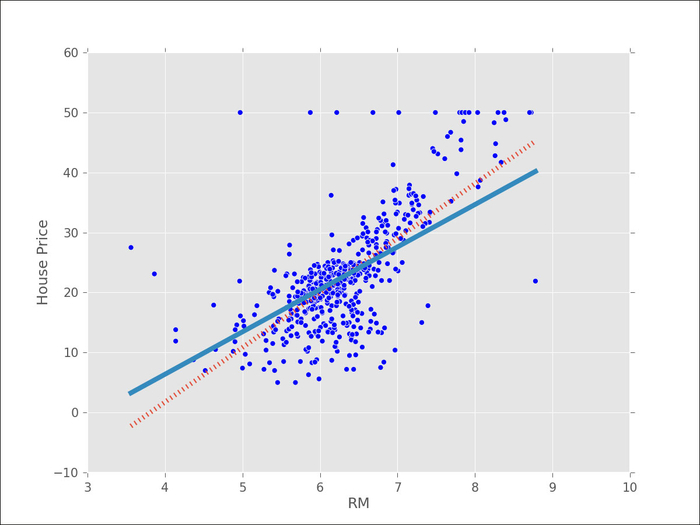The important variations of OLS regression fall under the theme of penalized regression. In ordinary regression, the returned fit is the best fit on the training data, which can lead to overfitting. Penalizing means that we add a penalty for overconfidence in the parameter values.
Tip
Penalized regression is about tradeoffs
Penalized regression is another example of the bias-variance tradeoff. When using a penalty, we get a worse fit in the training data as we are adding bias. On the other hand, we reduce the variance and tend to avoid overfitting. Therefore, the overall result might be generalized in a better way.
There are two types of penalties that are typically used for regression: L1 and L2 penalties. The L1 penalty means that we penalize the regression by the sum of the absolute values of the coefficients, and the L2 penalty penalizes by the sum of squares.
Let us now explore these ideas formally. The OLS optimization is given as follows:

In the preceding formula, we find the vector b that results in the minimum squared distance to the actual target y.
When we add an L1 penalty, we instead optimize the following formula:

Here, we are trying to simultaneously make the error small, but also make the values of the coefficients small (in absolute terms). Using L2 penalty means that we use the following formula:

The difference is rather subtle: we now penalize by the square of the coefficient rather than its absolute value. However, the difference in the results is dramatic.
Both the Lasso and the Ridge result in smaller coefficients than unpenalized regression. However, the Lasso has the additional property that it results in more coefficients being set to zero! This means that the final model does not even use some of its input features, the model is sparse. This is often a very desirable property as the model performs both feature selection and regression in a single step.
You will notice that whenever we add a penalty, we also add a weight λ, which governs how much penalization we want. When λ is close to zero, we are very close to OLS (in fact, if you set λ to zero, you are just performing OLS), and when λ is large, we have a model which is very different from the OLS one.
The Ridge model is older as the Lasso is hard to compute manually. However, with modern computers, we can use the Lasso as easily as Ridge, or even combine them to form Elastic nets. An Elastic net has two penalties, one for the absolute value and another for the squares.
Let us adapt the preceding example to use elastic nets. Using scikit-learn, it is very easy to swap in the Elastic net regressor for the least squares one that we had before:
from sklearn.linear_model import ElasticNet en = ElasticNet(fit_intercept=True, alpha=0.5)
Now we use en whereas before we had used lr. This is the only change that is needed. The results are exactly what we would have expected. The training error increases to 5.0 (which was 4.6 before), but the cross-validation error decreases to 5.4 (which was 5.6 before). We have a larger error on the training data, but we gain better generalization. We could have tried an L1 penalty using the Lasso class or L2 using the Ridge class with the same code.
The next plot shows what happens when we switch from unpenalized regression (shown as a dotted line) to a Lasso regression, which is closer to a flat line. The benefits of a Lasso regression are, however, more apparent when we have many input variables and we consider this setting next:

